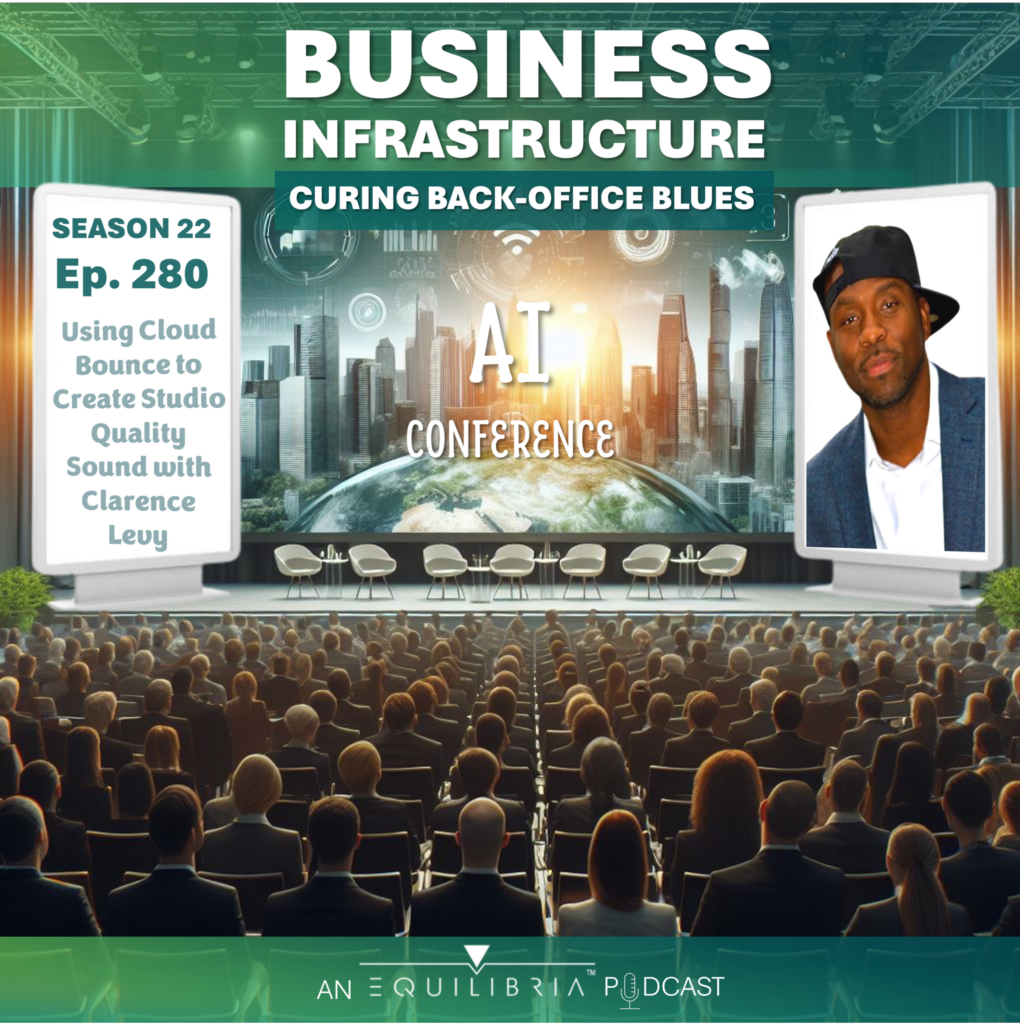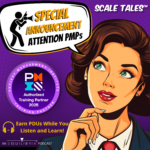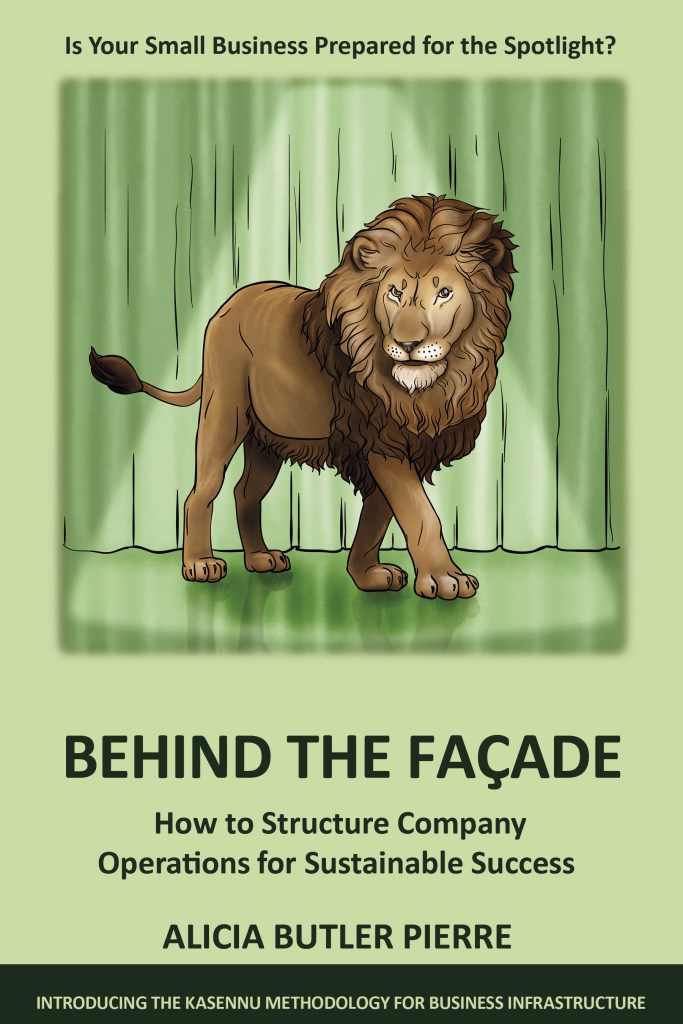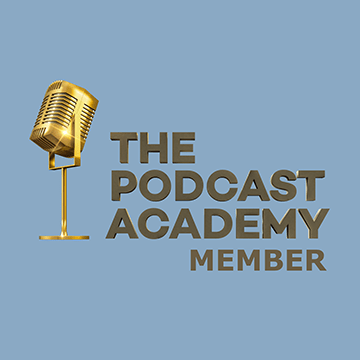Transcript
Is your small business growing faster than you can keep up with? It might be time to grow your team, document key processes, and make sure you’re using the right technologies to scale up operations. In other words, your company might need business infrastructure. At Equilibria, Incorporated we specialize in building business infrastructure.

Equilibria is proud to sponsor this special season which features an AI audio conference to advance your knowledge of business infrastructure. We hope you enjoy this episode!
Welcome back to Season 22 here on the Business Infrastructure podcast. I’m Alicia Butler Pierre and on this show, we share operational tips, strategies, and tactics to help you cure any back-office blues you might be experiencing.
In the last episode, you heard another keynote speaker talk about AI and the things we small business owners should be on the lookout for regarding our use of it – the good, the bad, and the ugly! We’re now resuming our demo portion of the conference and up next is our very own sound designer, Clarence Levy.
This demo session is a bit of a departure because I’m going to be on stage with Clarence as he talks about his love for music and how it ultimately led him to using AI tools to create the sharp, high-quality sound on shows like this one. He’s even going to give a demo so that you can hear the difference that a “mastered” recording gives.
Before we start, I want to remind you of our disclaimer – the nature of AI technology is changing fast, so it’s possible some of the information in this episode might be dated since the original presentation. We encourage you to learn what you can, test it, and most importantly have fun! And now for our next presentation….
This is Episode 280 – Using Cloud Bounce to Create Studio Quality Sound with Clarence Levy.
Welcome to this year’s AI conference. My name is Clarence Levy and I’m the owner of Sabor! Music Enterprises. Today we’re gonna talk about AI and its uses in the music industry and perceived effects.

And you all know me, I’m Alicia. We’re really excited that you can join us! Clarence, it’s so good to share the stage with you again! I’m not sure if you realized this, but the last time we did this we were presenting at the Podcast Movement conference in Las Vegas exactly one year ago.
Okay, everyone. I have a confession to make. Whenever I hand over an episode to Clarence, I have no idea what he does. I just know that the sound design he does to create the finished product is like putting the icing on the cake and its ALWAYS good! Wait a minute, it’s not just good…its great! So, I’m going to learn things right alongside you. So thank you for agreeing to be here, Clarence.
Thanks for having me.
Let me pull up our presentation here so everyone can see it. This picture everyone is from 1992 or 1993. This is a group of our high school classmates during a Shakespeare Festival! Look at us! There’s Clarence in the back. Notice how the rest of us in this picture have on medieval-inspired costumes, but Clarence is wearing a band uniform. Here’s what’s funny…we both ended up becoming engineers. Clarence has a degree in Electrical Engineering. He’s also a certified PMP, but his real passion is music! Exactly when did your love of music begin?
I think I got a pair of drumsticks put in my hand when I was like, three. And that was it! From that point on, it was music and percussion drums from that. It started with the drums and then from there, it just grew. My dad loved reggae, loved Bob Marley. That’s the first music I ever heard. And then from there, it was just the drums. And I had an uncle that was in the marching band at Peabody High School in Alexandria, Louisiana. And, from there I was watching him. And then of course, him and Jukebox right there at Southern and I basically took it from there. I’ve always lived in music.

Something I remember you telling me is that you played percussion from junior high on through high school and into Morehouse College here in Atlanta, GA. In fact, you were doing some pretty high-level stuff at Morehouse, music-wise. Can you share more about
that?
After graduating, I became the Drumline instructor, but I also, while I was there, started the Drumline fraternity, The Funk Squad fraternity. which I didn’t know what I was actually doing. I was just doing what I do and, you know? It was my 25th homecoming this past weekend. If you could see the group of individuals who have come through Funk Squad over that period of time, you would’ve been like, Wow!
Okay, here’s our next slide. As you can see it’s a picture of Clarence and the first band he started. After you graduated from Morehouse and Georgia Tech, I know you began working as an engineer. But at what point did you start your own band?
So, I started with the Salsa band. I’ve always been into Latin music and, Afro percussion, Afro Latin percussion and, I guess going to salsa clubs, dancing all the time. I went and bought a pair of bongos and figured I’m pretty good at this. A couple of my family members played, and of course we got mutual friends who also played instruments that played trombone and trumpet and everything. And they joined, and we did a little video. It actually sounded good. I think that was back in like 2007. From there, we started that band. And we did that for a long time. It grew to a 13-piece orchestra.
We were doing a lot of stuff around the City of Atlanta. And we were unique because we were young. A lot of Latin bands that played the old school salsa, the real, like the hard stuff or salsa brava as they, as they call it. They’re usually older, but we were young with a lot of energy. So, people liked us. Fast forward a couple years, I’d say maybe like 2011 or 12, I started the Brass Band, and from there using some of the same musicians, just pivoted.
That’s amazing, Clarence! So, I see on this next slide that you have several pictures of what appears to be scenes from different TV shows and movies. What’s this about?

And so now, we got onto the CW’s The Originals show. Four out of five seasons of that. And then we got into, a couple other things. A couple of us went Alvin and the Chipmunks movie. that was 20th Century Fox. That was my first like, big movie. That was awesome! Trailers, multiday shoots, choreography, everything. It was cool. and then from there we kept doing TV. And every now and then we’ll get TV, or we’ll get film. So that’s where I really wanna live. And then out of that I start on this podcast sound design journey.
It sounds like your company, Sabor! Music enterprises is a conglomerate where underneath it, there’s your band, TV and Film, sound design, and now podcast design. One thing, as I understand it, that’s common across all of those areas is the general production process, right? The overall process is four steps: 1) creating the music, 2) recording it, 3) mixing it, and 4) mastering it. Steps 1 and 2 are self-explanatory but can you describe to us what you mean by mixing?
So mixing, and any artist or any producer that’s just getting started, they go through these hurdles. You produce something, you created something, you composed something and you’re trying to get it heard. You want someone from the industry to hear it and hear your greatness and take you to meet Drake.
First thing that if you just take it straight, I don’t care how good it sounds, in the studio, on those speakers, on these monitors, you take it raw like that without any adjustment. It will not sound like that when you put it into anything commercial for anyone else to hear it. And when they hear it, it’s gonna be distorted. It may be off. So, then you need a trained ear. Usually it’s a studio engineer. They make big bucks because those guys work hard because they have to take every single element in your song and make sure that it’s blended correctly and that it has the right levels.
They do filtering. They do so much that’s where the hard work is if you ask me. Because, if you’re a creator and you love creating, the creating is not work. Blessed to have a talent to do something to get paid. That’s awesome. But then the studio engineer, I think that’s where the real work comes in with the mix, but those are the ones who make it sound pleasing to the ear.
Okay, that covers mixing. What about step #4 – mastering?
So, after it’s mixed, then you go back out and every artist does this…I just got a good mix, I’m going back to the guy and he’s gonna say, “Yeah, man, okay, now I can take you to Drake. We going tomorrow.” And they’ll hear 10 seconds of it, and they’ll say, “It’s not mastery. You can take this back.” From there you have to get it mastered and, when I do my music, if I’m doing live, a lot of times I’ll pay to have it done. I would pay to have most of my stuff done as it was going, commercial or if, if it was gonna be published.
But now the technology, AI, has now come so far because this is not the first time that I’ve used something like this. But in the beginning, it was just a lot of compression. They just made it loud, but it wasn’t a good master. And when I would go to a competition or something, I would play tracks that I had gone, that had gone through that particular tool. It didn’t stand up to the competition. So, I stayed away from that for a while, and I went back to letting people master my stuff. But now it’s come so far, you know, now they have all these different things they can do. Now they have tools, like found this new one that I started using. It’s a subscription model,
it’s called Cloud Bounce.
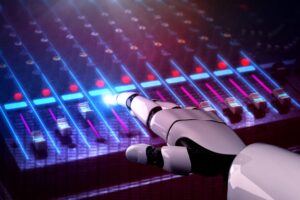
We’re in luck everybody because Clarence is going to give us a demo of how Cloud Bounce works. Clarence, it seems like you use this AI tool in some instances, but not every time. Sometimes that studio engineer is still needed. Is that right?
When you get to a certain level, it is gonna be needed. but at levels where you are only doing a few tracks, and I think podcasting and things like this are perfect. Like Cloud Bounce is perfect.
Okay, got it! And now…for the fun stuff. As you queue up Cloud Bounce for your demo, can we now shift to talking about the sound design work that you do here on this show? Once you receive an episode, the audio has already been edited. That is, there are parts that may have been cut, voiceovers are added as well as any ads. We then look to you to really make the audio come to life. Can you describe what you do?
Choosing the music, choosing what sound effects to use. That’s all me. Now, let’s say you want me to change a voice. There are some instances where I may use AI. Because what happens is that there are some tools in my audio software that will actually go in and I guess, same thing that Cloud Bounce does, but on a smaller level…basically taking whatever wave form and analyzing it and then reproducing the sound you want to hear.
So, if I request that you muffle someone’s voice or use a baby’s voice then…
I can go in and type in Voice. I can go into maybe, a certain type of filter, and I’ll just type in, Voice, or I’ll go into a compressor. It’s really trial and error. And everybody will tell you it’s trial and error. You’re doing different things ’cause you’re, you’re trying to create a new sound from something else. So, I’m using your voice and I wanna make it a higher pitch of course but it’s even more than that. If you want a baby sound, you want it to sound authentic. So, I’ll have to go in there and I’ll play around with different frequencies.
If I find a preset I think could be AI in a way. Because what they do is they’ll mimic a large room, small room. They’ll mimic an environment. So, I could take your voice and if I can take your voice, and if it’s real dry, if we want it to have like an echo, I can put a hallway and make it sound like you’re walking down, you’re talking in a hallway or something like that. and these are presets that are set by the computer that actually analyze whatever it is the analog that you’re bringing in. And then it basically exports the audio that you would like to hear. And then from there you have to adjust.
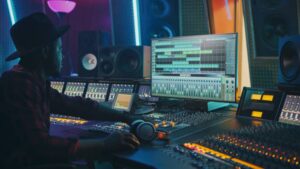
Isn’t that cool? Mastering gives that polished, professional sound that mixing in the studio just doesn’t quite give.
That’s exactly what it is. It gives it oomph that takes it from, Oh, you’re just playing around, to, Okay, you can play it on the radio, and it’s gonna compete with everything else that’s out there that’s considered to be professional.
It sets the levels without going overboard. It’s compression. It’s also boosting. But then it’s also like, like this thing that I’m going to show, Cloud Bounce, it will go in and first analyze whatever you put into it, and it’ll come back and tell you what it thinks it is, and then it masters according to that. So basically, if I put in a hard-hitting track, usually it’ll come back and say Hip hop, if it has a lot of bases. Usually, it’s pretty good. Sometimes it, it gets confused. Like for the podcast, it gets confused because it’s everything in your podcast, you got everything. We’ll see what it says when we do it with the episode I got queued up.
How long does it usually take the studio engineer you work with to finish the mastering part of the process?
It’s usually a one-to-two-day turnaround, and we can do different versions, instrumental vocals, whatever. From that point on, I can just send him different versions and he can master ’em just like that. But he has to set that algorithm first, and then from there I guess it works.
So, what takes the studio engineer potentially one to two days to master could take Cloud Bounce…
You’ll see..a few minutes. So like I said before, Cloud Bounce is a, it’s a subscription-type software that I use. And what I’m going to do is I’m gonna first grab a raw episode.
Let me explain what you just did, Clarence. When you walked over to the laptop you have here on stage, you opened the Cloud Bounce app on your desktop. But for those who want to experiment with it first, you can type in CloudBounce.com. Once at the website, you’ll see an area where you can import an audio file and test its mastering capabilities right away.
Now, the podcast episode cover that you see on the screen features one of our former guests, Jennifer Wang. Jennifer is a prominent event designer and planner in Los Angeles. Clarence is about to demo how he uses Cloud Bounce by using her episode as an example.
This is right after I’ve gone in and done editing, mixing, added music and everything. this is a 30 minute or more long WAV file. So, this is not like some three, four-minute song, right? And, let me get this going here. All right. So basically, you come into it, you just log in. And then what I do after I’ve sat here and put in the time to put everything together, I’m feeling good at this point, I can exhale. The next thing I’ll do is I’ll grab the WAV file, drag it in. There it is!
To clarify, Clarence just selected the WAV file featuring Jennifer’s episode and dragged it into Cloud Bounce. There’s a message that appears indicating that the software is analyzing. But what exactly is it analyzing, Clarence?
It’s analyzing the track. It’s analyzing the peaks and valleys. It’s analyzing everything. It’s trying to find out first what type of music is it so that it can set the levels that it needs to set someone when they did the programming. It’s basically learning. It’s sitting there and it’s learning whatever it is that’s coming into it, whatever that input is. So that now it’ll say…okay, it’s giving you ambient. It says ambient.
Where do you see that? Oh wait, I see it now! I see the name of the original audio file on the screen and directly underneath it, I see the word, “Ambient.” What are some of the other things Cloud Bounce could potentially say after its analysis?
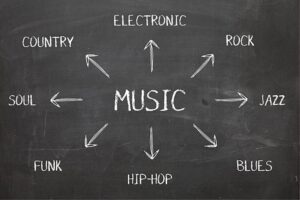
So, it could come back and say, rock, pop, hip hop, drum and bass, EDMB pop, all different types of classical. then there’s Cloud Bounce Originals. This is from the original, so I had cloud Bounce before, but, and so these were the original, I guess presets or whatever it would come back with. So there may be one or two extras in here, like World or something like that. But for the most part, it’ll come back, and it’ll say, This is what I think it is. And it goes ahead and then masters it. Let’s listen to what this sounds like ambient. This is original. Right after this got off, I finished my job. Now I’m pressing the button here.
So, you hear the difference there. I mean, it is very, it’s a big difference between the original.
The master…
Okay. It’s definitely clearer.
It’s crisp, it’s radio clear. The older tools would just boost everything and it was loud, but this doesn’t do that. And there’s some things I can come back and control, like sometimes what I usually do is I’ll put a, I’ll say widener – it gives a little bit more enhancement. And I’ll sometimes put warmer. It just gives it more of a full feel. I’ll do stuff like that based on what type of music was in the episode, stuff like that. And then once I’m done with that piece, if that’s good I can even play with the loudness, because there was, sometimes whenever we had problems with the voices being a little bit too sharp, the Ss and Ts.
I use what they call a de-esser that takes off the intensity of the Ss and Ts. But then also in here, I can come in here and just kind of turn the loudness down a little bit and it still gives you that full, that master sound, but it’s just, like I say, it turns down that, Oh, it’s just loud factor. So, when I’m done with that piece, if I feel good with the adjustments I’ve made, Something like that. I, I’m feeling good, and I’m almost done. I’m getting ready to, to send Alicia, the next episode. I’m happy. So then, I hit this button here. Oh, I’ll change it here. And I’ll just, I’ll change the, change this to master, just so you know.
And this is the file name that you’re updating as you save this mastered version, right? You’re adding the words, “M-A-S” after the original file name. As you save this file, I’m curious – why did Cloud Bounce identify or classify this file as “Ambient?”
I’ll just say MAS So I know this is the one. And then I export this to the desktop. Ambient could have pretty much anything in it. Ambient music could have a very faint, melody or a harp going on. And all of a sudden you can have a big bass drum or a gong, you know, transitioning to another part or something that sounds very low and deep and cinematic. It can have things where the bounds would be very, very wide.
So, I guess it opens it up so that it can actually, I guess analyze and, and do its thing on not only the music, which would be, you know, the heavier sound. And not only that, but also just the audio. It takes a couple minutes, a few minutes, see, okay, now it’s gonna spit out the final, the final file that I actually shared with you, and then you approve it.
And once I approve it, the file is then uploaded into our portal and shared with our production assistant who makes sure it gets onto the schedule to be published and distributed around the world! This was so cool, Clarence! Thanks for giving us a peek into your world of sound design.
I know there’s so much more to this, but I’m wondering if we can now transition from this demo to talking about AI and its impact on the music industry as a whole. About a year ago there was a big news story about some songs featuring two top Canadian entertainers – Drake and The Weeknd. The problem was that they had nothing to do with it – it was all produced via AI!
It was a single with Drake and The Weeknd, and it, it went viral. I was just reading about it not too long ago shortly after that, there was a whole Drake album from whatever. And I remember listening to it, and, and the thing about it is, is that it did sound like Drake, but there was a cheapness to it. I could tell by the texture of the voice that it wasn’t quite him.
It’s like one of those things where you listening to a song and you like, Is that Drake? That guy sounds like Drake to me. A lot of people that I talked to, they were saying the same thing, but it was impressive, nonetheless. But it was, I, I feel like it, it lacked the human part.

A deep fake. Man, that’s, that’s scary on so many levels!
I mean, yeah. You know, there was some money to be made. Right now, I do know that, of course Drake and The Weeknd are on a huge, very powerful record label and, they were able to get it squashed and pretty quickly. They worked out how money would, where would it go. They can actually go to the YouTubes and the Spotifys and tell ’em, “Oh no, you reroute that check this way!”
I hear you. But what’s your advice for smaller, independent artists that are out there just trying to get established? They don’t have deep pockets or the backing of a large music company. What’s your advice for them as well as people who may not necessarily be artists but want to learn a little more about how to mix and master while leveraging AI?
To folks who are really on the side of, really wanting to make things sound really good, I guess that’s a step beyond just creating the music. It is more so now, let me make this sound pleasing, and we already think it sounds pleasing when we do it, when we create it, right? But if you were to put it out there on a regular platform, we would quickly hear if it was up against something else out there on the radio that it is not that pleasing. And people would start to, you know, even if it’s decent, they wouldn’t like it because it’s not up to par, so to speak. So, I would say definitely for those who think that maybe, Oh, I don’t play an instrument, or I don’t do this, but I
still love sound, I know when I hear something that sounds good, I can pick things out.
You have a good ear, so to speak. this is a way to get into the industry and you can work with pretty much up and coming to any anybody if you get good at it because it’s a much-needed skill. And the thing about it is, if you’re independent, if you’re doing the mixing, using things like Cloud Bounce can definitely help you on the mastering side ‘cause that’s where it gets really expensive as well. This helps you to be able to, to do this and compete and actually give yourself a chance if you don’t have the big baller budget.
The B3 – the Big Baller Budget…well on that note, Clarence thank you so much for giving us an up close and personal view of what you do as a musician and sound designer. Much continued success to you, my friend, and let’s keep collaborating and doing more great things together!
We definitely will. Thank you for having me on. As you can see, the file has completed and in under what 30 minutes you have a mastered file that’s ready to go to the world!
And we couldn’t do it without you. Let’s give it up for Clarence Levy!
Thank you very much!
If you’d like to connect with Clarence, follow his bands’ gigs and exciting projects, or want to know more about sound design, then definitely follow him on Instagram and YouTube. We’ll have links to that and the other resources he shared available for quick access at BusinessInfrastructure.TV. Again, that’s BusinessInfrastructure.TV.
Thank you for listening! If you enjoyed this episode, then please subscribe and give us a five-star rating and review.

Coming up in our next session is another demo that I’m positive will pique your interest since it involves an AI solution for something we all deal with in business – meetings!
Make sure to come back to the place wherever you’re listening to this episode, so that you don’t miss this session! Until then, remember to stay focused and be encouraged. This entrepreneurial journey is a marathon and not a sprint.
This episode was produced by me, Alicia Butler Pierre. Audio editing by Olanrewaju Adeyemo. Voiceover by Kenya A. Moses. Original score and sound design by Sabor! Music Enterprises. Video editing by Gladiola Films. A special thank you to Grant Revilla for creating the show notes.
This is the Business Infrastructure – Curing Back-Office Blues podcast.


